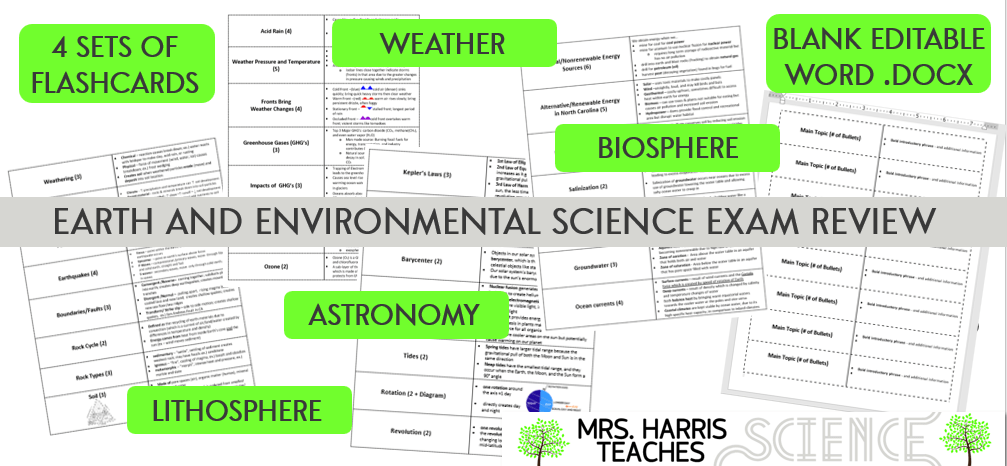Earth and Environmental Science Exam Review
In North Carolina, Earth and Environmental Science is a required high school science course for all students. For this class, I have center rotations for review before each test (with one center being Jeopardy). But for the NC earth and environmental science final exam review, I also use flashcards. Cue the groans of my 9th graders.
Yup, I integrate the use of flashcards into my science instruction. Years ago, even I would turn my nose up at using flashcards due to their implicit “drill and kill” stereotype. However, flashcards can be a dynamic part of instruction if used thoughtfully.
I believe in balance in my classroom instruction. Inquiry lessons are important! Study habit lessons are important! Personally, I could not have survived college science courses without flashcards.
Earth and Environmental Science Essential Standards
Following the North Carolina Essential Standards for Earth/Environmental Science, I have four sets of flashcards. Each set aligns with the big ideas of the course. I really poured over the standards when creating this earth science exam review. I wanted the cards to touch on all the big topics in the course. At the same time, I limited each set to fit on the front of one page.
- Lithosphere Flashcards – reviews weathering, soil, rocks, volcanoes, and earthquakes
- Weather and Climate Flashcards – review weather and atmosphere topics like fronts, pressure, and greenhouse gases
- Biosphere and Water Flashcards – covers renewable and nonrenewable energy sources, farming techniques, groundwater, and ocean currents
- Astronomy Flashcards – reviews Kepler’s Laws, precession, nutation, barycenter, sun, tides, rotation, and revolution
Here are some best practices when using flashcards in your classroom:
- Engage and Explore First – Implement flashcards AFTER the initial exploration and learning of the material. Students need to engage in hands-on and inquiry-based instruction first. I use flashcards last only as review.
- Set a Limit – Setting a limit forces you to really look at what was is most important. I limit flashcards to the front of one page typed. Your limit may be 7 index cards.
- Create Partnerships – Have student partnerships quiz each other using their flashcards in class. Encourage helpful partners (i.e. “It starts with an E.” or “Convergent boundaries is your hint.”) I walk around and make sure students are engaged in their partnerships. This is when I really listen to how students discuss each concept. My ear is tuned in to misconceptions.
- Focus on Understanding Concepts – Focus on science CONCEPTS first and vocabulary second. Discuss with students (as 1 on 1 as possible) the meaning of each concept.
- Be Flexible – Have students create their own flashcard wording. Or, allow student input on the cards you create. For example, my students have suggested changes to either add information to a flashcard or to change the wording. As a class, these changes were made. This helps create a sense of ownership and pride over the flashcards they created.
- Be “Low Tech”– Don’t print it out. Have students write out their own flashcards themselves.
- Go Beyond Plain Text – Require, model, and encourage the use of bold print, italics, underlining, color, and pictures.
- Give Time – Give students 10-15 minutes of class time to study each day. For example, in the first five minutes, students read their flashcards silently. The next five minutes one student quizzes the other. This means for the entire five minutes, the same student is the “helpful teacher” and the other is the “learning student”. The last five minutes, the students switch roles. I spend a week on each of my four flashcard sets for the month leading up to the exam. As students become familiar with the flashcards I drop the first five minutes of silent reading.
- Hold Student Accountable – Have a purpose for students to study the flashcard information beyond just the final exam. I have high standards and generally require students to write out all the flashcard information for a quiz. Again, cue all the student groans now. At the front of the classroom, I put the front of each card (and sometimes a few hints) as students furiously write for the quiz. Since there are four weeks of this, I do mix up this process week to week to maintain student motivation.
Using Flashcards in Science Classrooms
The effectiveness and simplicity of incorporating flashcards into your exam review are worth exploring. For me, only spending 10 minutes on flashcards each class worked best. That focused attention only lasts so long, even for the most discipline ninth-grader. And honestly, even breaking that up into two five minute blocks of time was a challenge for some students. I think the study habit of using flashcards is hugely important for any student, and even more so for those that pursue a science field in college.


Leave a Reply